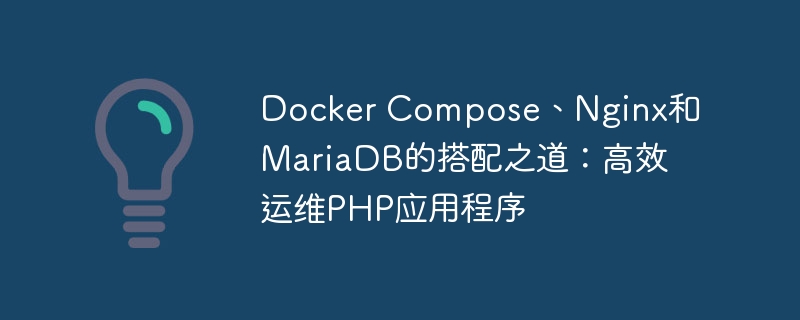

How to match Docker Compose, Nginx and MariaDB: Efficiently operate and maintain PHP applications
Introduction:
In today's Internet era, applications The demand and scale of the network continue to grow, so efficient operation and maintenance and deployment solutions are crucial. Docker is a popular containerization platform that solves the complexities of application deployment and management. Docker Compose is a powerful tool of Docker that allows us to define and manage a combination of multiple containers through a simple configuration file. In this article, we will focus on how to use Docker Compose with Nginx and MariaDB to efficiently operate and maintain PHP applications, and provide specific code examples.
1. Introduction to Docker Compose
Docker Compose is a tool officially launched by Docker for defining and managing multiple Docker containers. Through a simple YAML file, you can easily define multiple containers, dependencies between containers, network configuration, etc.
Benefits of using Docker Compose include:
2. Use of Nginx
Nginx is a lightweight, high-performance web server that can be used as a reverse proxy server, load balancing server, static resource server, etc. use. In our PHP application, we can use Nginx as a reverse proxy server to forward requests to the PHP-FPM server on the backend.
The following is a sample configuration file (docker-compose.yml) using Docker Compose and Nginx:
version: '3'
services:
nginx:
image: nginx:latest
ports:
- 80:80
volumes:
- ./nginx.conf:/etc/nginx/nginx.conf
- ./public:/var/www/html
php:
image: php:7.4-fpm
volumes:
- ./public:/var/www/html
networks:
default:
external:
name: my-networkIn the above configuration, we define a service named nginx and a name For php services. Among them, the nginx service uses the official nginx image and maps the container's port 80 to the host's port 80. At the same time, we mount the nginx configuration file (nginx.conf) and the public directory where our PHP application is located into the container.
3. Use of MariaDB
MariaDB is a free, open source relational database management system and a branch of MySQL, providing high-performance and high-reliability database solutions. In our PHP application we can use MariaDB as backend database.
The following is a sample configuration file (docker-compose.yml) using Docker Compose and MariaDB:
version: '3'
services:
db:
image: mariadb:latest
ports:
- 3306:3306
environment:
- MYSQL_ROOT_PASSWORD=secret
- MYSQL_DATABASE=my_database
- MYSQL_USER=my_user
- MYSQL_PASSWORD=my_password
volumes:
- ./data:/var/lib/mysql
php:
image: php:7.4-fpm
volumes:
- ./public:/var/www/html
networks:
default:
external:
name: my-networkIn the above configuration, we define a service named db and a service named For php services. Among them, the db service uses the official MariaDB image and maps the container's 3306 port to the host's 3306 port. We also set the relevant configuration of the database through environment variables, such as root password, database name, user and password, etc. At the same time, we mount the database folder into the container to ensure persistent storage of data.
4. Complete sample configuration
The following is a complete sample configuration for efficient operation and maintenance of PHP applications using Docker Compose, Nginx and MariaDB:
version: '3'
services:
nginx:
image: nginx:latest
ports:
- 80:80
volumes:
- ./nginx.conf:/etc/nginx/nginx.conf
- ./public:/var/www/html
depends_on:
- php
networks:
- my-network
php:
image: php:7.4-fpm
volumes:
- ./public:/var/www/html
networks:
- my-network
db:
image: mariadb:latest
ports:
- 3306:3306
environment:
- MYSQL_ROOT_PASSWORD=secret
- MYSQL_DATABASE=my_database
- MYSQL_USER=my_user
- MYSQL_PASSWORD=my_password
volumes:
- ./data:/var/lib/mysql
networks:
- my-network
networks:
my-network:
external: trueIn the above configuration, we have defined a service named nginx, a service named php and a service named db. At the same time, we also defined an external network named my-network to connect these three services. The nginx service depends on the php service, so we use the depends_on keyword to specify this dependency.
5. Summary
The above are methods and specific code examples for using Docker Compose, Nginx and MariaDB to efficiently operate and maintain PHP applications. By using the Docker Compose tool, we can quickly build and manage applications containing multiple containers, improving deployment efficiency and operation and maintenance convenience. As a high-performance web server, Nginx can help us implement functions such as reverse proxy and load balancing. MariaDB, as a reliable database management system, provides high-performance and high-availability data storage solutions for our applications.
I hope this article will help you understand and use Docker Compose, Nginx and MariaDB. I wish you better results and experience in the process of operating and maintaining PHP applications!
The above is the detailed content of The combination of Docker Compose, Nginx and MariaDB: Efficiently operate and maintain PHP applications. For more information, please follow other related articles on the PHP Chinese website!
 The difference between k8s and docker
The difference between k8s and docker
 nginx restart
nginx restart
 Detailed explanation of nginx configuration
Detailed explanation of nginx configuration
 Detailed explanation of nginx configuration
Detailed explanation of nginx configuration
 What are the differences between tomcat and nginx
What are the differences between tomcat and nginx
 What are the methods for docker to enter the container?
What are the methods for docker to enter the container?
 What should I do if the docker container cannot access the external network?
What should I do if the docker container cannot access the external network?
 What is the use of docker image?
What is the use of docker image?




